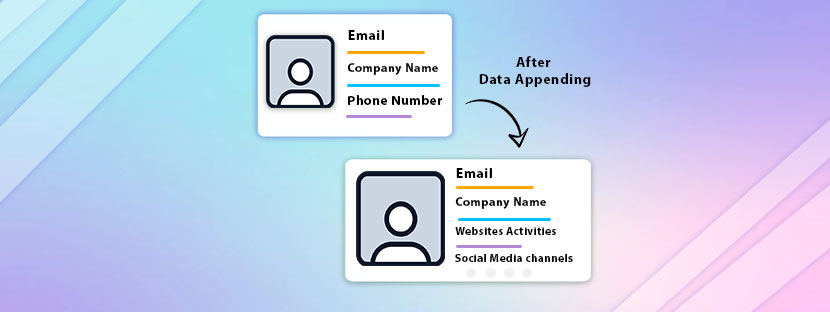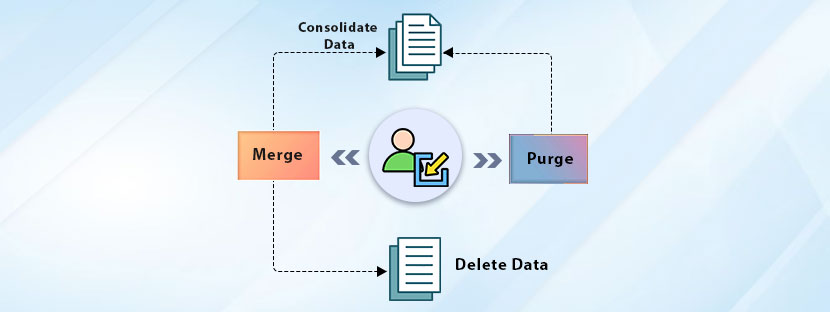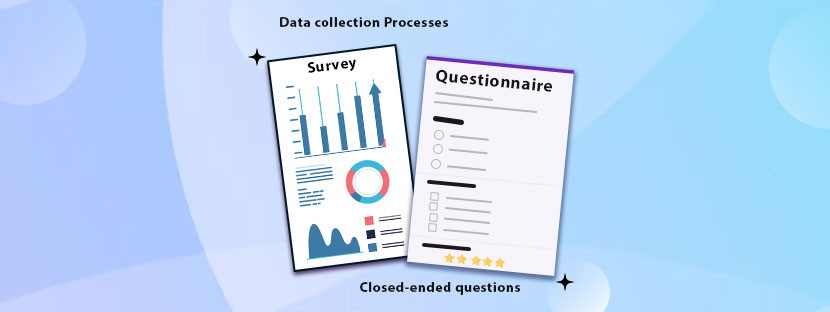In This Article
Have you figured out yet… why your marketing efforts are not generating the results you expected?
Probably the main culprit is data incompleteness.
Yes, even the most creative marketing campaigns fail due to incomplete data. And, the consequences are large beyond the failed outreach attempts. Reputation damage and a hold on long-term revenue-earning capacity are at stake.
So what’s the solution?
Well, data appending is the hands-on solution you have here. Appending your B2B marketing database means filling up missing information with valid data backups. It works well in marketing operations. That’s why most of the marketing agencies always recruit data agencies to get their incomplete data filled using data appending strategies.
Let’s discuss this matter further in this complete blog. I assure you’ll get detailed information about data appending and understand how it fills data into your B2B marketing database.
Okay to start?
Pain of incomplete databases
When email addresses bounce back, job titles no longer match with actual roles, phone numbers connect to the wrong department, it creates a complete mess. Even the top-level creative campaigns fail to target their audience.
You must be spending too much on your ambitious marketing campaigns, but the results are not effective in the end. Basically, your customer acquisition costs would climb while decreasing the conversion rate.
Inaccurate…outdated…& incomplete data. These three elements cause the main pain in marketing campaigns. Let’s elaborate on this matter here.
⓵ First comes the pain of bad data
Having old records in your database counts as a serious threat to your reputation, especially if it’s happening in marketing. For example, your marketing database stores some phone numbers, which have not been updated yet from the last year. Quite natural, your sales team will dial these numbers and get the wrong people on the call.
Besides the reputation loss, you’ll also end up burning the productive time of your sales team.
The same thing can happen with your outreach team. They’ll send highly lucrative emails to the wrong inboxes. As you haven’t validated and updated your email listing recently.
All your data will turn into bad records if you do not update it before the due time.
Back to bad data, email campaigns mostly get bounced because of outdated emails. Many companies that tried sending emails without appending have ended up decreasing their email sender reputation rates. Phone numbers are marked as spam, and there are many such things that happen when you target the wrong people.
All of this happened because of the presence of bad data in your B2B marketing database. Remove this bad data as soon as possible. Otherwise, it can lower your team’s morale and confidence at the end of the day.
⓶ Pain of losing revenue opportunities
Every contact detail you collect and every move you make with those contacts increases opportunities. Means every contact comes with a business opportunity. It depends on you how you’re going to convince the contact and close a deal.
What if you collect the contact information, but it gets outdated, and you approach the contact right after that?
We all can guess. You’ll not make the deal. Either you target the wrong person, or you won’t find the person whose information you collected earlier. People change their contact details very fast. You have to track, update their contacts, and stay in the loop. Or else, you can lose touch.
Also, you must think about the cost factors. Collecting and validating each B2B contact costs a certain amount to companies. At the end, businesses would end up increasing the costs but without making any sales. That’s the reason data appending to B2B databases can boost revenue opportunities while minimizing the cost factors.
⓷ Pain of data decaying
Each data comes with an expiry date. After that date is over, the data becomes stale and is no longer useful.
For example, your marketing team has collected data of people who work in US-based Fintech firms (based in California). Probably your database would look like;
| Name | Job Role | Company Name | Region | Email ID | Phone Number | Address |
|---|---|---|---|---|---|---|
| Jimmothy Halpert | Sales Executive | Dunder Mifflin Fins Corp. | CA | Jim@dmfc.com | 125-4568-9654 | Bay Area, San Francisco |
After a year, when you update the data, the data of the same person can look like this;
| Name | Job Role | Company Name | Region | Email ID | Phone Number | Address |
|---|---|---|---|---|---|---|
| Jimmothy Halpert | Sales Manager | Sabre Fintech Firm | CA | Jim@sabre.com | 567-987-5421 | Los Angeles |
Well, the person has switched companies and got a promotion to the managerial level. Residential address, company address, phone numbers, and email, everything has changed. The old data becomes nothing but garbage. Even if you try to contact using the old data, you’ll not get a connection.
The only solution here is to follow the data cleansing methodology and prevent data decay. It will help you remove old records and keep all data updated with due measures.
How data appending helps
Data appending is a process of adding missing information, updating contact information, adding firmographic details, behavioral data, and other necessary information. It makes databases complete, so outreach campaigns can get started.
Filling the gaps in your database is the main purpose of data appending. It enriches your existing data as new data will get added to your database. Most of your data records will get updated via the appending process. Let’s see how appending adds new data to the existing records.
➣ Examine your current data
Find what the shortcomings are that you’re facing within your database. Examine it thoroughly using insights. Appending is mostly done to contact details, firmographic information, demographic, and behavioral data. Identifying the gap is the first step of appending.
For example, you may have contact details with you, but you don’t have the behavioral data. Therefore, your sales team has not come out with an outreach strategy yet. If they get some behavioral insights into your data, it would become easy for them to approach the contact.
In this case, finding the need for behavioral data besides the contact information has arisen after examining the database. That’s why you should always examine your data before starting the appending process. It will reveal the appending requirements.
➣ Match with external sources
Adding data to the missing fields is not a core task of your business. It is just an additional task that you need to do to have a complete record. That’s why most of the businesses choose third parties to append their data.
To append your existing database, it’s essential to trust external sources. It’s a limitation for a company to append its data through its own source. If that happens, it will increase the cost matter. That’s why it’s always preferable to trust an external source to add up essential data. You can get the data very fast if you follow this method.
➣ Enrich and validate
It’s always mandatory to have valid data in your B2B marketing database. Otherwise, you’ll end up having the same problem that you have faced before. Valid information in the gaps is essential to survive.
Again, I’m making it very clear that data appending does not necessarily mean you’ll add up data as per your convenience. You have to make a serious attempt to append data. If you think you’ll add any type of data to your database, it will work. You’re wrong.
On the other side, to maintain accuracy, you can team up with an external data validator. It will make the task easier and faster. Remember, you’re appending your B2B marketing database. Each contact listed in the database can impact your revenue-earning potential. Also, you must have spent enough to acquire the data. Thus, consider a validation test for your data before you finally append.
Data appending can boost customer insights: here’s how
Accurate data in your marketing database can take your operations to the next level. Enhanced datasets aren’t just helpful for outreach operations, but rather generate productive business insights. Explore here how you can get that.
Raw data into intelligence
Data appending is the right kind of tool that makes a basic contact list into the right profiles. You may have contact information of a company, but data appending can provide you with more information about the company. For example, the size of the company, the industry the company belongs to, revenue teams, and many other information.
When you append your database, you could add behavioral insights, which include;
➥ Purchase history
➥ Website interaction
➥ Clicks and searches
➥ Social media engagement, etc
Empower your marketing team with such detailed information about your target audience. They can frame personalized strategies to make conversion easy.
Creation of a unified customer profile
Data spread across multiple databases makes operations slower. Navigating them becomes a hurdle at times. Having a consolidated database can empower your operations to a great extent.
The biggest advantage of a unified customer profile is that it stores the A to Z of customer information. Suppose one of your website visitors attended your webinar recently, and the same visitor has booked a call with you. Now, I’ll discuss two situations to explain the need for a unified customer data.
▸ First case scenario: You count two incidents (website attendance and booking a call) differently. You’ll think both customers are different and separate entities.
▸ Second case scenario: As you maintain a unified customer record, you’ll count both incidents as being done by one customer. And, you count it as one single customer.
Overall, you can track your customer journey and understand how your customers are coming into your sales pipeline clearly. You can minimize the issue of double entry completely when you unify all your data. It will save your time and resources from counting one single customer multiple times.
Make a data-driven decision
Take your business decision confidently with full support from appended data. Appending has an alternative meaning, which is enriching. Your existing database gets enriched when you fill all the gaps with relevant datasets.
As a result, you could have enough data with you to make a constructive and informed business decision. All your business strategies must have a backup with accurate data insights. Data-driven decisions required major support from high-end data records.
Appending data means adding up latest data to your existing database. Appending also means updating your data records with accurate information. Strategies with a solid data backup can create major impacts on the data operations. If enabling the best decision in your database is your prime focus, you must append your records once in a while.
Some real-case scenario
Let’s take an example of a SaaS company for reference to explain how data appending works.
Suppose SpaceHR (HR-solution provider company, a fictitious reference) wants to collaborate with B2B companies that are looking for smart HR solutions. For that, it has planned its outreach and promotion campaign. It has designed its website and added web assets to make everything lucrative.
The marketing team of SpaceHR has added a tracker to the website to collect visitors’ information. Later, when the campaign ended, the team analyzed the reports and declared the tracker had performed well. It has collected cookie details of every visitor.
➧ Company Name
➧ Company Email
➧ Company Phone Number
On a surface level, SpaceHR has collected the necessary information so the next sales operations can get started. But the only problem is that the sales team could not have any other information besides the basics.
We are living in the era of hyper-personalization, where customized messages decide the open rates. Thus, having basic information is not going to work in this case.
Therefore, SpaceHR takes help from the data entry team once again to append the first round of data, i.e., the basic data. The companies considered email and phone appending, along with adding additional details of their website visitors.
Hence, they have added the following sets of data to the existing contact database.
✅ Job titles (CEO, CFO, Communication Manager)
✅ Company revenue
✅ Activities of the websites (clicks, stays, scroll-throughs)
✅ Social media activities
✅ Communications channels other than the traditional setup
Once you get all the data with you, you can start your marketing operation in a full-fledged manner. You’ll have all the reasons to approach your audience in the best possible way for your business growth. Besides that, your sales team can prioritize leads based on your generated metrics. You can quickly connect with your audience and attract opportunities fast.














